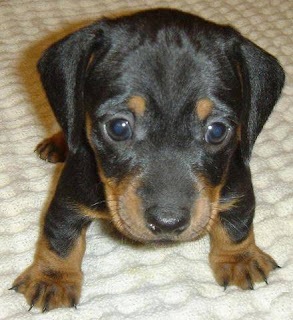
The Chihuahua is the smallest breed of dog in the world that why most pet lovers love Chihuahua because it is easy to own and took care of it, it is not hustle to bring them on your vacation or any outings. It is named after the state of Chihuahua in Mexico, where it was discovered in 1850. Some academics believe the Chihuahua to be descended from Chinese hairless dogs—who may have crossed over from Asia to Alaska on a land bridge before continental separation created the Bering Strait—and bred with the ancient Toltec and Aztec Techichi dog, creating the modern-day Chihuahua. The American Kennel Club registered its first Chihuahua in 1905.
Chihuahuas are known best of their small size breed dog, with its large eyes, and large erect ears. There are two varieties of Chihuahua: the smooth-coat and the long-coat. Most long-coat Chihuahua has very thin hair, but other long coats have a very dense, thick coat.

Appearance
Chihuahuas are best known for their small size, large eyes, and large, erect ears. The AKC (American Kennel Club) recognizes two varieties of Chihuahua: the long-coat and the smooth-coat. Many long-coat Chihuahuas have very thin hair, but other long coats have a very dense, thick coat. The breed standards of Chihuahua’s are not generally specify a height, only a weight and a description of their overall proportions. For this height only varies more than within many other breeds. .However, pet-quality Chihuahuas (that is, those bred or purchased as companions rather than show dogs) can, and do, range above these weights, to 10 pounds (4.5 kg), or even more if they have large bone structures or are allowed to become overweight. This does not mean, however, that they are not purebred Chihuahuas, it only means that they do not meet the requirements to enter a conformation show. Oversize Chihuahuas are seen in some of the best, and worst, bloodlines.
The AKC Chihuahua standard] lists under color: "Any color-Solid, marked or splashed". This allows for all colors from solid blacks to solid whites, spotted, or a variety of other colors and patterns. A few examples are Fawn, Red, Cream, Chocolate, Blue, and Black.
Patterns, all with or without white markings, include:
- Sable
- Irish spotting
- Piebald spotting
- Extreme white spotting
- Brindle
- Masks
- Merle
- Tan points
Classifying Chihuahua colors can be complicated due to the large number of possibilities. Examples would be a Blue Brindle or a Chocolate and Tan. Colors and patterns can combine and affect each other, resulting in a very high degree of variation. That said, the classic Chihuahua color remains Fawn. No color or pattern is considered more valuable than the others. Although blue is considered rare, it is all just a matter of personal preference.
Chihuahuas are prized for their devotion, ferocity and personality. Their curious nature and small size make them easily adaptable to a variety of environments, including the city and small apartments. Chihuahuas are often stereotyped as high-strung, though it has been shown that correct training and socialization can result in an outstanding companion animal.

Chihuahuas are not well-suited as small children's pets because of their size, temperament and tendency to bite when frightened. It is recommended that children be 12 years or older before adding a Chihuahua to one's home. Also, many Chihuahuas focus their devotion on one person, becoming overly jealous of that person's human relationships. This can be mitigated through socialization. Chihuahuas also tend to have a "clannish" nature, often preferring the companionship of other Chihuahuas over other dogs.

HEALTH
Overfeeding a Chihuahua can be a grave danger to the small dog's health, shortening their life and leading to diabetes.
This breed requires expert veterinary attention in areas such as birthing and dental care. Chihuahuas are also prone to some genetic anomalies, often neurological ones, such as epilepsy and seizure disorders.
Chihuahuas, and other toy breeds, are also prone to the sometimes painful disease Hydrocephalus. It is often diagnosed by the puppy having an abnormally large head during the first several months of life, but other symptoms are more noticeable (since "a large head" is such a broad description). Chihuahua puppies exhibiting Hydrocephalus usually have patchy skull platelets rather than a solid bone, and typically are lethargic and do not grow at the same pace as their siblings. A true case of Hydrocephalus can be diagnosed by a veterinarian, though the prognosis is grim.
Chihuahuas are also known for their moleras, a soft spot in their skulls. Chihuahuas are the only breed of dog to be born with an incomplete skull. The molera does fill in with age, but great care needs to be taken during the first six months until the skull is fully formed. Many veterinarians are not familiar with Chihuahuas as a breed, and mistakenly confuse a molera with hydrocephalus. The Chihuahua Club of America has issued a statement regarding this often deadly misdiagnosis.

Chihuahuas can also be at risk for hypoglycemia, or low blood sugar. Left unattended, hypoglycemia can lead to coma. Chihuahuas are also prone to eye infections due to their large, round, protruding eyes and their relatively low ground clearance. Chihuahuas also have a tendency to tremble but this is not a health issue, rather it takes place when the dog is stressed or excited. One reason for this may be because small dogs have a higher metabolism than larger dogs and therefore dissipate heat faster. Although figures often vary, as with any breed, the average lifespan for a Chihuahua is approximately 8 to 18 years of age.
Chihuahuas are sometimes picky eaters, and care must be taken to provide them with adequate nutrition. At the same time, care must be exercised not to overfeed this tiny breed. Overweight Chihuahuas are prone to joint injuries, tracheal collapse, chronic bronchitis, and shortened life span.
 Tinkerbell (born October 31, 2002 in
Tinkerbell (born October 31, 2002 in 



























